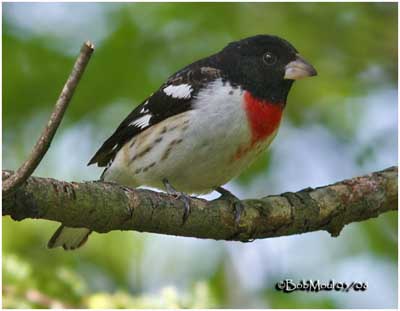
Rose-breasted Grosbeak
Pheucticus ludovicianus
Passeriforme Order – Cardinalidae Family
BIOMETRICS:
Length : 18-21 cm
Wingspan : 29-33 cm
Weight : 39-49 g
LONGEVITY: Up to 9 years
DESCRIPTION:
Rose-breasted Grosbeak is a plump bird with pale heavy bill.
Adult male is distinctive, with black head, upperparts and tail. We can see a pinkish-red triangular patch on the breast, and a white patch on the rump (very conspicuous in flight).
Underparts, wing bars, primary patches and tail’s corners are white.
The bill is large, conical and pale. Eyes are brown. Legs are blackish.
Fr: Cardinal à poitrine rose
All : Rosenbrust-Kernknacker
Esp : Piquigrueso Degollado
Ital : Beccogrosso pettorosa
Nd : Roodborstkardinaal
Russe : Красногрудый дубоносовый кардинал
Sd: Brokig kardinal
Photographs by René Lortie
His website: http://rlortie.ca/
Photographs by Bob Moul
His website:
Nature Photography
Text by Nicole Bouglouan
Sources:
FIELD GUIDE TO THE BIRDS OF NORTH AMERICA - National Geographic Society - ISBN: 0792274512
A GUIDE TO THE BIRDS OF MEXICO AND NORTHERN CENTRAL AMERICA by Steve N. G. Howell, Sophie Webb - Oxford University Press - ISBN: 0198540124
A GUIDE TO THE BIRDS OF COLOMBIA by Steven L. Hilty and William L. Brown - Princeton University Press – ISBN 069108372X
BIRDS OF THE GREAT BASIN – by Fred A. Ryser - Univ of Nevada Pr -ISBN: 0874170796
All About Birds (Cornell Lab of Ornithology)
Animal Diversity Web (University of Michigan Museum of Zoology)
What Bird-The ultimate Bird Guide (Mitchell Waite)
Wikipedia (Wikipedia, The Free Encyclopedia)

Adult female and 1st winter male have dark brown upperparts with conspicuous dark streaks. Underparts are whitish.
Wings show two whitish wing bars. In flight, inner coverts may be bright yellow (pinkish-red in male).
Head is streaked too. Crown-sides and ear-coverts are blackish brown. Middle of crown, eyebrow and rounded line under the cheek are whitish.
Bill is strong and pale.
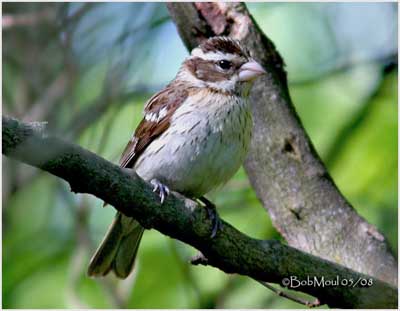
In winter plumage, the black, white and pink pattern of male is duller, due to the pale brownish edges on head and body feathers, including the rump patch. But wings and tail remain black and white.
VOICE: SOUNDS BY XENO-CANTO
Rose-breasted Grosbeak’ usual call is a weak metallic shrill “eek” or “kink”.
Song is liquid but often low-pitched. Male often sings during the flight display. Female sings too, but briefly and softer.
Male sings from the nest when incubating or caring the young. It may sometimes sing at night.
HABITAT:
Rose-breasted Grosbeak lives in open woodlands, near water, in thick shrubs, tall trees close to open areas, near marshes, in pastures, thick small trees’ plantations, at forest edges, in parks and gardens.
RANGE:
Rose-breasted Grosbeak is an American species, living in southern and centre Canada and eastern US.
It winters until Mexico and in northern parts of South America.
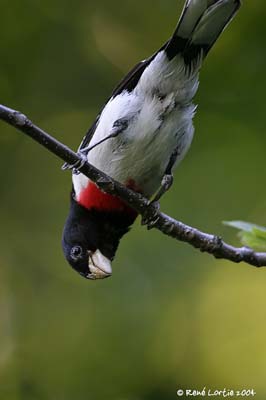
BEHAVIOUR:
Rose-breasted Grosbeak performs chases of the female while displaying. It crouches with dropped open wings and fanned, slightly raised tail. It draws in the head with the nape touching the back.
It sings while waving head and body, as a kind of erratic dance. Sometimes, mates may rub their bills during the displays.
They produce one or two broods per year. Pairs are monogamous.
Rose-breasted Grosbeak feeds by hopping, and the female feeds more than the male.
During winter, they form groups of about twenty birds in plantations and clearings.
FLIGHT:
Rose-breasted Grosbeak performs chases during the courtship displays. The flight allows to see the pink patches on the male’s underwings, and the yellow patches of the female.
REPRODUCTION:
Rose-breasted Grosbeak nests in deciduous forests, woodlands and second grows.
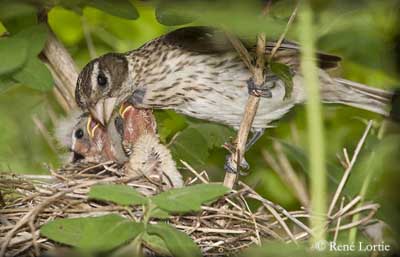
Nest is a fairly loose structure made with twigs and plant materials. The interior is lined with finer twigs, rootlets and hair. It is cup-shaped, situated between 1, 50 and 4, 50 metres above the ground.
The male has to select the nest-site, and the female builds the nest, with help of male.
Female lays 3-5 pale green, blue or bluish-green eggs, with brown or purple markings. Incubation lasts about 13-14 days, by both parents.
At hatching, chicks are motionless, naked, with closed eyes and fed.

They fledge at about 9 to 12 days, and both adults care them. They are independent about three weeks later.
If the pair starts a second brood, the male looks after the young birds while the female builds a new nest and starts a second laying.
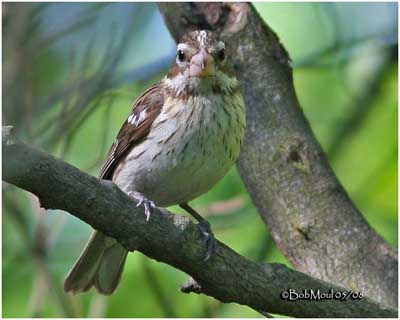
DIET:
Rose-breasted Grosbeak feeds mainly on blossoms and flowers, although it also consumes insects, grasshoppers, aphids, fruits and seeds.
It often visits the feeding-stations, mainly during the migrations.
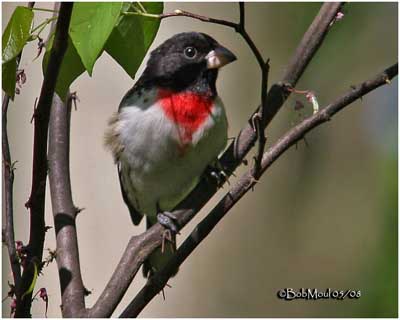
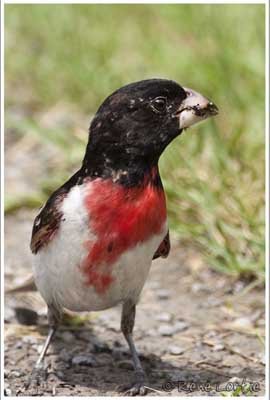
PROTECTION / THREATS / STATUS:
This species is fairly common within the habitat.
On wintering areas, the Rose-breasted Grosbeak is very appreciated as cage-bird. But this bird is also useful because it consumes large numbers of insects.
However, some declines are observed in several regions, and mainly in the eastern parts of the range.